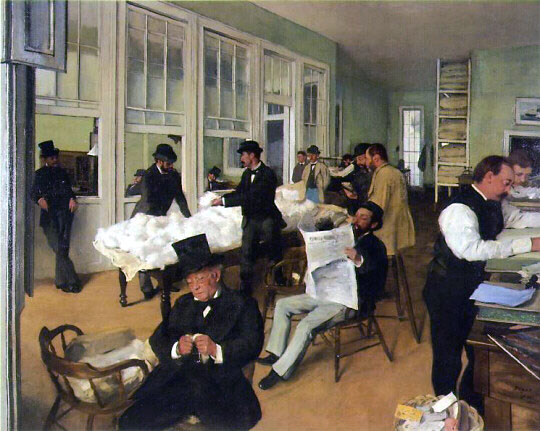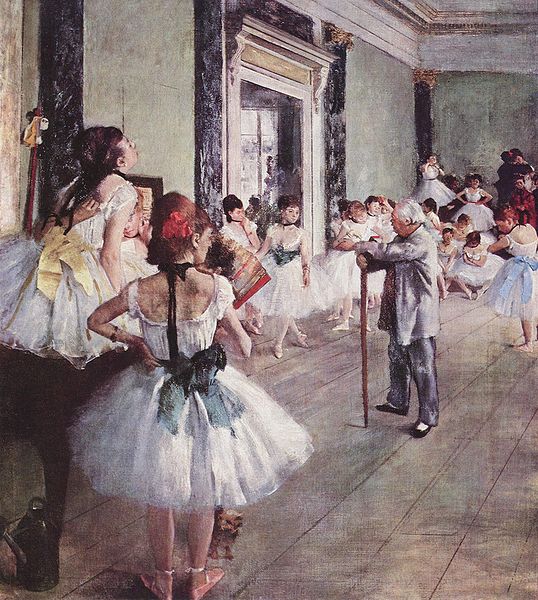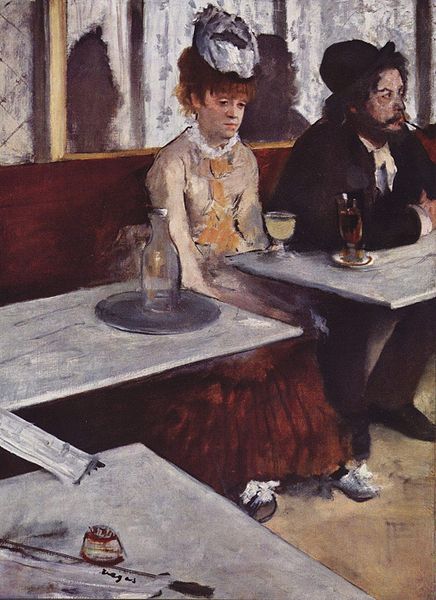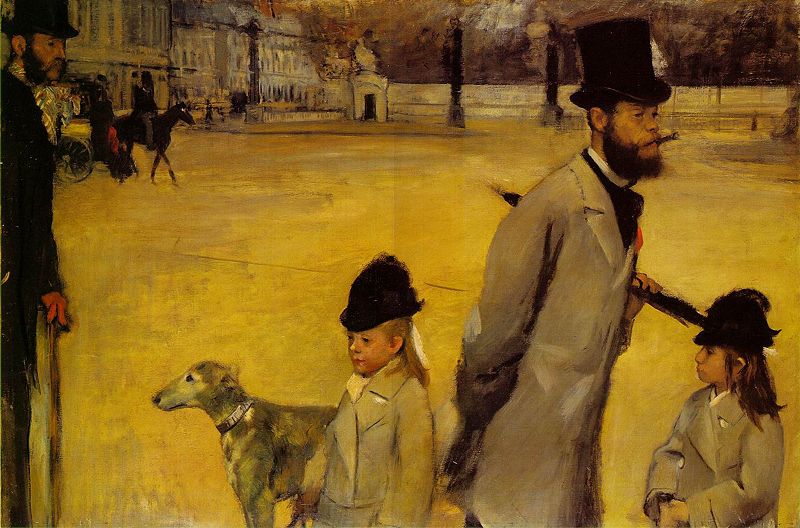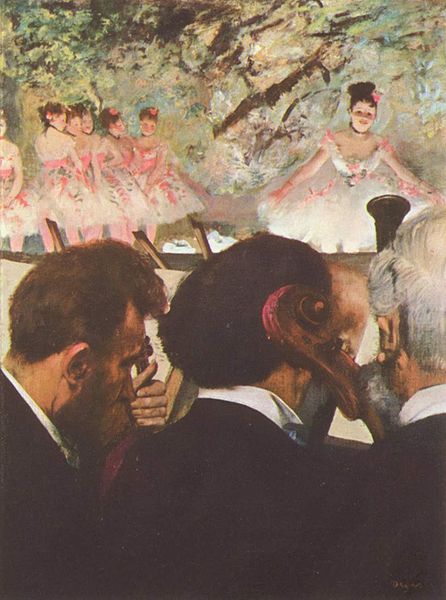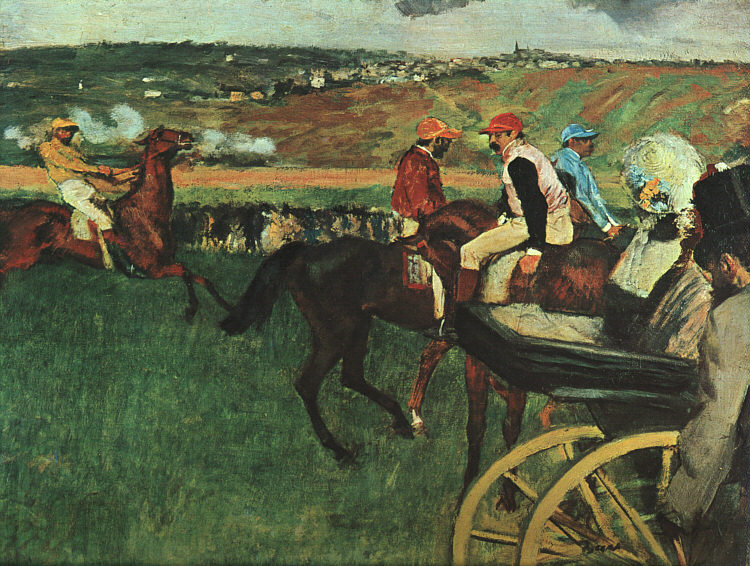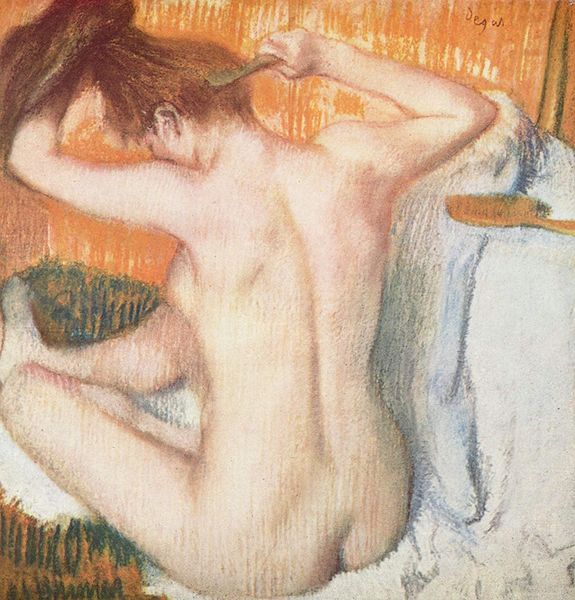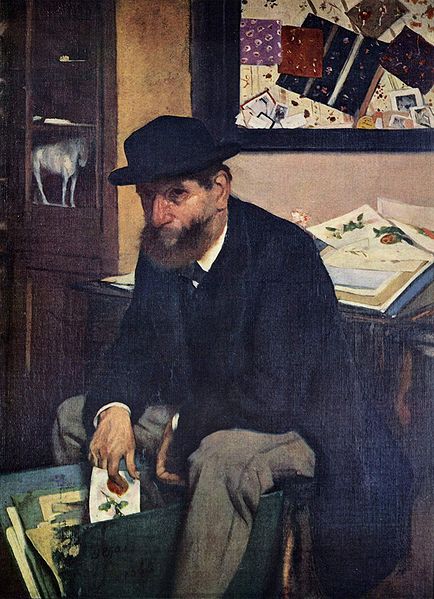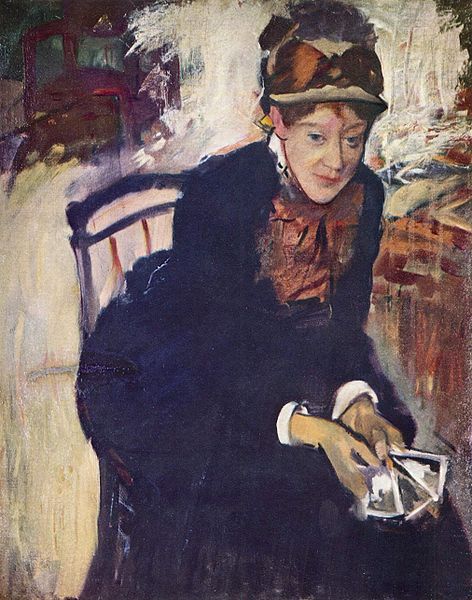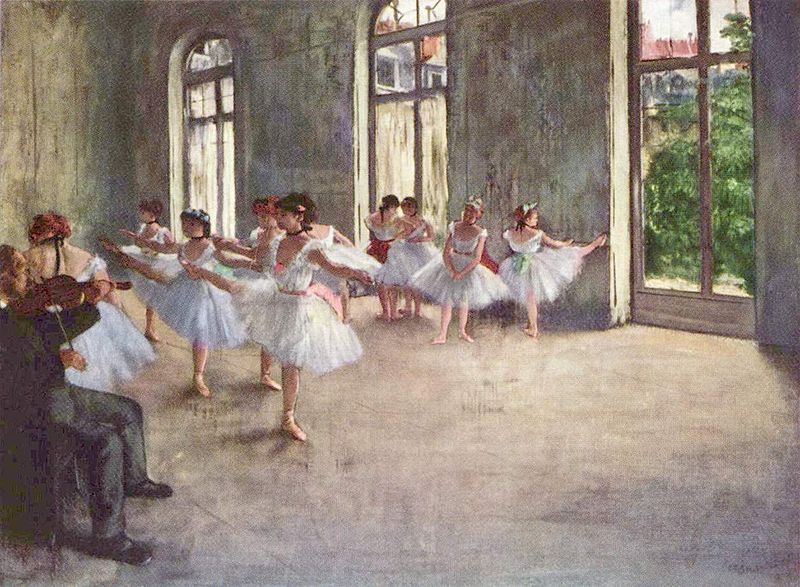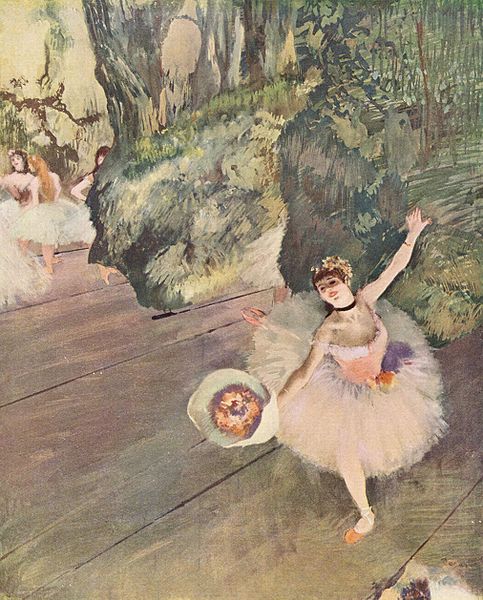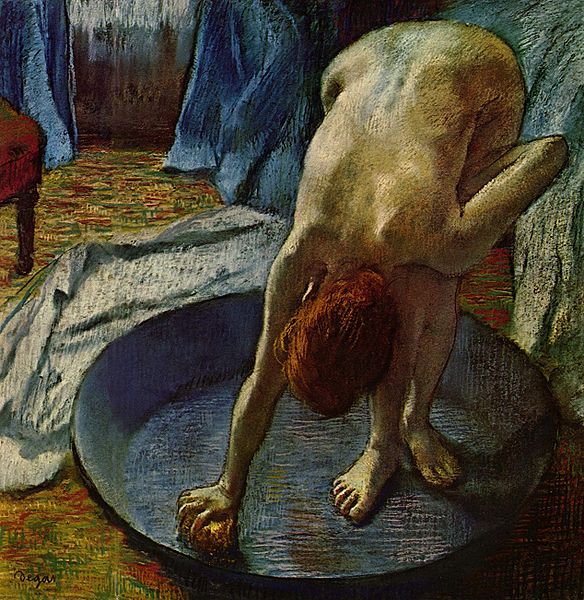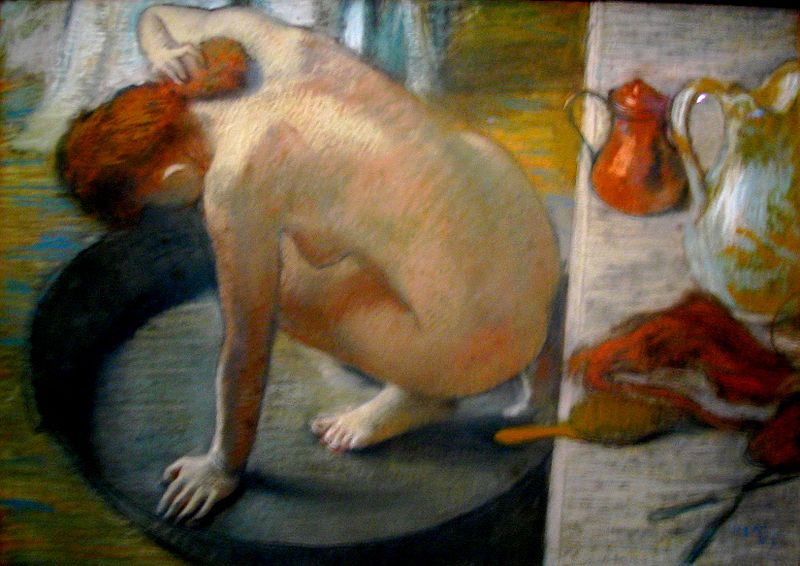<Back to Index>
- Mathematician Aleksandr Yakovlevich Khinchin, 1894
- Painter Edgar Degas, 1834
- Founder of the Republic of Ecuador Juan José Flores y Aramburu, 1800
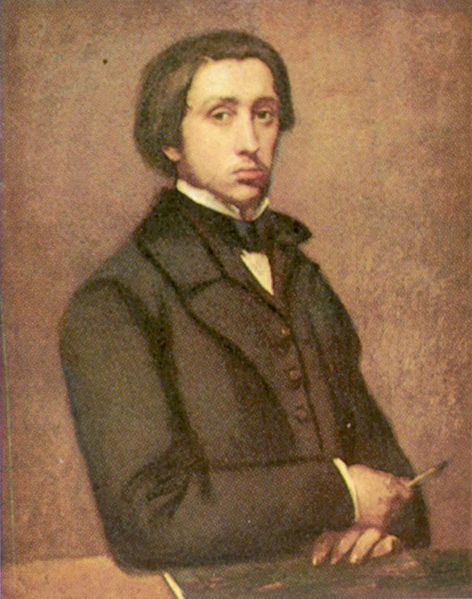
Edgar Degas (19 July 1834 – 27 September 1917), born Hilaire-Germain-Edgar De Gas, was a French artist famous for his work in painting, sculpture, printmaking and drawing. He is regarded as one of the founders of Impressionism although he rejected the term, and preferred to be called a realist. A superb draughtsman, he is especially identified with the subject of the dance, and over half his works depict dancers. These display his mastery in the depiction of movement, as do his racecourse subjects and female nudes. His portraits are notable for their psychological complexity and depiction of human isolation.
Early in his career, his ambition was to be a history painter,
a calling for which he was well prepared by his rigorous academic
training and close study of classic art. In his early thirties, he
changed course, and by bringing the traditional methods of a history
painter to bear on contemporary subject matter, he became a classical
painter of modern life. Degas was born in Paris, France, the eldest of five children of Célestine Musson De Gas and Augustin De Gas, a banker.
The family was moderately wealthy. His mother died when Degas was
thirteen, after which his father and grandfather were the main
influences on his early life. At age eleven, Degas (in adulthood he
abandoned the more pretentious spelling of the family name) began his schooling with enrollment in the Lycée Louis-le-Grand, graduating in 1853 with a baccalauréat in literature. Degas
began to paint early in his life. By eighteen, he had turned a room in
his home into an artist's studio, and in 1853 he registered as a
copyist in the Louvre. His father, however, expected him to go to law school. Degas duly registered at the Faculty of Law of the University of Paris in November 1853, but made little effort at his studies there. In 1855, Degas met Jean Auguste Dominique Ingres,
whom he revered, and whose advice he never forgot: "Draw lines, young
man, and still more lines, both from life and from memory, and you will
become a good artist." In April of that same year, Degas received admission to the Ecole des Beaux-Arts, where he studied drawing with Louis Lamothe, under whose guidance he flourished, following the style of Ingres. In July 1856, Degas traveled to Italy, where he would remain for the next three years. In 1858, while staying with his aunt's family in Naples, he made the first studies for his early masterpiece, The Bellelli Family. He also drew and painted copies after Michelangelo, Raphael, Titian, and other artists of the Renaissance, often selecting from an altarpiece an individual head which he treated as a portrait. By 1860 Degas had made more than seven hundred copies of works including Italian Renaissance and French Classical art. Upon his return to France in 1859, Degas moved into a Paris studio large enough to permit him to begin painting The Bellelli Family — an imposing canvas he intended for exhibition in the Salon, although it remained unfinished until 1867. He also began work on several history paintings: Alexander and Bucephalus and The Daughter of Jephthah in 1859–60; Sémiramis Building Babylon in 1860; and Young Spartans around 1860. In 1861, Degas visited his childhood friend Paul Valpinçon in Normandy,
and made the earliest of his many studies of horses. He exhibited at
the Salon for the first time in 1865, when the jury accepted his
painting Scene of War in the Middle Ages, which attracted little attention. Although he exhibited annually in the Salon during the next five years, he submitted no more history paintings, and his Steeplechase — The Fallen Jockey (Salon
of 1866) signaled his growing commitment to contemporary subject
matter. The change in his art was influenced primarily by the example of Edouard Manet, whom Degas had met in 1864 (while both were copying the same Velázquez portrait in the Louvre, according to a story that may be apocryphal). At the outbreak of the Franco-Prussian War in
1870, Degas enlisted in the National Guard, where his defense of Paris
left him little time for painting. During rifle training his eyesight
was found to be defective, and for the rest of his life his eye
problems were a constant worry to him. After the war, in 1872, Degas began an extended stay in New Orleans, Louisiana, where his brother René and a number of other relatives lived. Staying in a house on Esplanade Avenue, Degas produced a number of works, many depicting family members. One of Degas' New Orleans works, depicting a scene at The Cotton Exchange at New Orleans, garnered favorable attention back in France, and was his only work purchased by a museum (that of Pau) during his lifetime. Degas
returned to Paris in 1873. The following year his father died, and in
the subsequent settling of the estate it was discovered that Degas'
brother René had amassed enormous business debts. To preserve
the family name, Degas was forced to sell his house and a collection of
art he had inherited. Dependent for the first time in his life on sales
of his artwork for income, he produced much of his greatest work during
the decade beginning in 1874. By
now thoroughly disenchanted with the Salon, Degas joined forces with a
group of young artists who were intent upon organizing an independent
exhibiting society. The first of their exhibitions, which were quickly
dubbed Impressionist Exhibitions, was in 1874. The Impressionists
subsequently held seven additional shows, the last in 1886. Degas took
a leading role in organizing the exhibitions, and showed his work in
all but one of them, despite his persistent conflicts with others in
the group. He had little in common with Monet and
the other landscape painters, whom he mocked for painting outdoors.
Conservative in his social attitudes, he abhorred the scandal created
by the exhibitions, as well as the publicity and advertising that his
colleagues sought. He
bitterly rejected the label Impressionist that the press had created
and popularized, and his insistence on including non-Impressionist
artists such as Jean-Louis Forain and Jean-François Raffaëlli in their exhibitions created rancor within the group, contributing to their eventual disbanding in 1886. As
his financial situation improved through sales of his own work, he was
able to indulge his passion for collecting works by artists he admired:
old masters such as El Greco and such contemporaries as Manet, Pissarro, Cézanne, Gauguin, and Van Gogh. Three artists he idolized, Ingres, Delacroix, and Daumier, were especially well represented in his collection. In the late 1880s, Degas also developed a passion for photography. He photographed many of his friends, often by lamplight, as in his double portrait of Renoir and Mallarmê. Other photographs, depicting dancers and nudes, were used for reference in some of Degas' drawings and paintings. As the years passed, Degas became isolated, due in part to his belief that a painter could have no personal life. The Dreyfus Affair controversy brought his anti-Semitic leanings to the fore and he broke with all his Jewish friends. His
argumentative nature was deplored by Renoir, who said of him: "What a
creature he was, that Degas! All his friends had to leave him; I was
one of the last to go, but even I couldn't stay till the end." Although he is known to have been working in pastel as
late as the end of 1907, and is believed to have continued making
sculpture as late as 1910, he apparently ceased working in 1912, when
the impending demolition of his longtime residence on the rue Victor
Massé forced a wrenching move to quarters on the boulevard de
Clichy. He never married and spent the last years of his life, nearly blind, restlessly wandering the streets of Paris before dying in 1917. Degas is often identified as an Impressionist,
an understandable but insufficient description. Impressionism
originated in the 1860s and 1870s and grew, in part, from the realism
of such painters as Courbet and Corot.
The Impressionists painted the realities of the world around them using
bright, "dazzling" colors, concentrating primarily on the effects of
light, and hoping to infuse their scenes with immediacy. Technically,
Degas differs from the Impressionists in that he "never adopted the
Impressionist color fleck", and he continually belittled their practice of painting en plein air. "He
was often as anti-impressionist as the critics who reviewed the shows",
according to art historian Carol Armstrong; as Degas himself explained,
"no art was ever less spontaneous than mine. What I do is the result of
reflection and of the study of the great masters; of inspiration,
spontaneity, temperament, I know nothing." Nonetheless,
he is described more accurately as an Impressionist than as a member of
any other movement. His scenes of Parisian life, his off-center
compositions, his experiments with color and form, and his friendship
with several key Impressionist artists — most notably Mary Cassatt and Edouard Manet — all relate him intimately to the Impressionist movement. Degas' style reflects his deep respect for the old masters (he was an enthusiastic copyist well into middle age) and his great admiration for Jean Auguste Dominique Ingres and Eugène Delacroix. He was also a collector of Japanese prints, whose compositional principles influenced his work, as did the vigorous realism of popular illustrators such as Daumier and Gavarni. Although famous for horses and dancers, Degas began with conventional historical paintings such as The Young Spartans,
in which his gradual progress toward a less idealized treatment of the
figure is already apparent. During his early career, Degas also painted
portraits of individuals and groups; an example of the latter is The Bellelli Family (c.1858–67),
a brilliantly composed and psychologically poignant portrayal of his
aunt, her husband, and their children. In this painting, as in The Young Spartans and
many later works, Degas was drawn to the tensions present between men
and women. In his early paintings, Degas already evidenced the mature
style that he would later develop more fully by cropping subjects
awkwardly and by choosing unusual viewpoints. By
the late 1860s, Degas had shifted from his initial forays into history
painting to an original observation of contemporary life. Racecourse
scenes provided an opportunity to depict horses and their riders in a modern context. He began to paint women at work, milliners and laundresses. Mlle. Fiocre in the Ballet La Source,
exhibited in the Salon of 1868, was his first major work to introduce a
subject with which he would become especially identified, dancers. In
many subsequent paintings dancers were shown backstage or in rehearsal,
emphasizing their status as professionals doing a job. It is these
dancers who have determined Degas's popularity to this day, from 1870
he increasingly painted ballet subjects. Amongst other reasons the
ballet series was easy to sell and seeing as his brother's debts had
left the family bankrupt, Degas needed money. Degas began to paint café life as
well. He urged other artists to paint "real life" instead of
traditional mythological or historical paintings, and the few literary
scenes he painted were modern and of highly ambiguous content. For
example, Interior (which has also been called The Rape)
has presented a conundrum to art historians in search of a literary
source; internal evidence suggests that it may be based on a scene from Thérèse Raquin. As
his subject matter changed, so, too, did Degas' technique. The dark
palette that bore the influence of Dutch painting gave way to the use
of vivid colors and bold brushstrokes. Paintings such as Place de la Concorde read
as "snapshots," freezing moments of time to portray them accurately,
imparting a sense of movement. The lack of color in the 1874 Ballet Rehearsal on Stage and the 1876 The Ballet Instructor can
be said to link with his interest in the new technique of photography.
The changes to his palette, brushwork, and sense of composition all
evidence the influence that both the Impressionist movement and modern
photography, with its spontaneous images and off-kilter angles, had on
his work. Blurring the distinction between portraiture and genre pieces, he painted his bassoonist friend, Désiré Dihau, in The Orchestra of the Opera (1868-69)
as one of fourteen musicians in an orchestra pit, viewed as though by a
member of the audience. Above the musicians can be seen only the legs
and tutus of the dancers onstage, their figures cropped by the edge of
the painting. Art historian Charles Stuckey has compared the viewpoint
to that of a distracted spectator at a ballet, and says that "it is
Degas' fascination with the depiction of movement, including the
movement of a spectator's eyes as during a random glance, that is
properly speaking 'Impressionist'." Degas'
mature style is distinguished by conspicuously unfinished passages,
even in otherwise tightly rendered paintings. He frequently blamed his
eye troubles for his inability to finish, an explanation that met with
some skepticism from colleagues and collectors who reasoned, as Stuckey
explains, that "his pictures could hardly have been executed by anyone
with inadequate vision." The artist provided another clue when he described his predilection "to begin a hundred things and not finish one of them," and was in any case notoriously reluctant to consider a painting complete. His
interest in portraiture led him to study carefully the ways in which a
person's social stature or form of employment may be revealed by their physiognomy, posture, dress, and other attributes. In his 1879 Portraits, At the Stock Exchange, he portrayed a group of Jewish businessmen with a hint of anti-Semitism. In 1881 he exhibited two pastels, Criminal Physiognomies,
that depicted juvenile gang members recently convicted of murder in the
"Abadie Affair". Degas had attended their trial with sketchbook in
hand, and his numerous drawings of the defendants reveal his interest
in the atavistic features thought by some nineteenth century scientists to be evidence of innate criminality. In
his paintings of dancers and laundresses, he reveals their occupations
not only by their dress and activities but also by their body type. His
ballerinas exhibit an athletic physicality, while his laundresses are
heavy and solid. By the later 1870s Degas had mastered not only the traditional medium of oil on canvas,
but pastel as well. The dry medium, which he applied in complex layers
and textures, enabled him more easily to reconcile his facility for
line with a growing interest in expressive color. In the mid-1870s he also returned to the medium of etching, which he had neglected for ten years, and began experimenting with less traditional printmaking media — lithographs and experimental monotypes. He was especially fascinated by the effects produced by monotype, and frequently reworked the printed images with pastel.
These
changes in media engendered the paintings that Degas would produce in
later life. Degas began to draw and paint women drying themselves with
towels, combing their hair, and bathing. The strokes that model the
form are scribbled more freely than before; backgrounds are simplified.
The
meticulous naturalism of his youth gave way to an increasing
abstraction of form. Except for his characteristically brilliant
draftsmanship and obsession with the figure, the pictures created in
this late period of his life bear little superficial resemblance to his
early paintings. Ironically, it is these paintings, created late in his
life, and after the heyday of the Impressionist movement, that most
obviously use the coloristic techniques of Impressionism. For
all the stylistic evolution, certain features of Degas's work remained
the same throughout his life. He always painted indoors, preferring to
work in his studio, either from memory or using models. The
figure remained his primary subject; his few landscapes were produced
from memory or imagination. It was not unusual for him to repeat a
subject many times, varying the composition or treatment. He was a
deliberative artist whose works, as Andrew Forge has written, "were
prepared, calculated, practiced, developed in stages. They were made up
of parts. The adjustment of each part to the whole, their linear
arrangement, was the occasion for infinite reflection and experiment." Degas himself explained, "In art, nothing should look like chance, not even movement". Degas, who believed that "the artist must live alone, and his private life must remain unknown", lived
an outwardly uneventful life. In company he was known for his wit,
which could often be cruel. He was characterized as an "old curmudgeon"
by the novelist George Moore, and he deliberately cultivated his reputation as a misanthropic bachelor. Profoundly
conservative in his political opinions, he opposed all social reforms
and found little to admire in such technological advances as the telephone. He fired a model upon learning she was Protestant. Although Degas painted a number of Jewish subjects from 1865 to 1870, his anti-Semitism became apparent by the mid 1870s. His 1879 painting At The Bourse is
widely regarded as strongly anti-Semitic, with the facial features of
the banker taken directly from the anti-Semitic cartoons rampant in
Paris at the time. The Dreyfus Affair,
which divided Paris from the 1890s to the early 1900s, further
intensified his anti-Semitism. By the mid 1890s, he had broken off
relations with all of his Jewish friends, publicly
disavowed his previous friendships with Jewish artists, and refused to
use models who he believed might be Jewish. He remained an outspoken
anti-Semite and member of the anti-Semitic "Anti-Dreyfusards" until his death.
